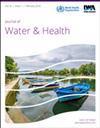Effect of handwashing on the reduction of Escherichia coli on children's hands in urban slum Indonesia
IF 2.5
4区 环境科学与生态学
Q3 ENVIRONMENTAL SCIENCES
引用次数: 0
Abstract
Abstract Poor hand hygiene practice has been linked to an increase in the number of infections among children in urban slums. Hands are considered an intersection for bacterial transmission, but it is unclear whether the handwashing technique affects bacteria elimination. This study investigated the effect of handwashing on the concentration of Escherichia coli (E. coli) and factors related to its reduction among children in an urban slum in Bandung, Indonesia. We observed handwashing and conducted repeated hand swabs before and after handwashing among 137 participants. The mean E. coli concentration on the hands decreased after handwashing, with a higher reduction in E. coli count among students who used soap and had soap contact for more than 10 s during handwashing. Cleaning in-between fingers, using soap, soap contact for more than 10 s, and drying hands with a single-use towel were effective factors for reducing E. coli concentration after handwashing (p < 0.05). More than half of the swab samples (59%) tested positive for E. coli after handwashing, indicating that the children's handwashing technique was not effective in completely removing E. coli from the hands. Moreover, sustained and consistent handwashing practice as a daily behavior in children would maximize the effect.洗手对印度尼西亚城市贫民窟儿童手部大肠杆菌减少的影响
不良的手卫生习惯与城市贫民窟儿童感染人数的增加有关。手被认为是细菌传播的交叉点,但目前尚不清楚洗手技术是否会影响细菌的消除。本研究调查了洗手对印度尼西亚万隆城市贫民窟儿童中大肠杆菌(E. coli)浓度的影响及其减少的相关因素。我们观察了137名参与者的洗手情况,并在洗手前后进行了反复的手拭子测试。洗手后,手上的平均大肠杆菌浓度下降,在洗手过程中使用肥皂并接触肥皂超过10秒的学生中,大肠杆菌数量下降幅度较大。手指间清洁、使用肥皂、接触肥皂10 s以上、用一次性毛巾擦干双手是降低洗手后大肠杆菌浓度的有效因素(p <0.05)。洗手后,超过一半的拭子样本(59%)检测出大肠杆菌阳性,这表明儿童的洗手技术不能有效地完全去除手上的大肠杆菌。此外,持续和一致的洗手实践作为儿童的日常行为将最大限度地发挥作用。
本文章由计算机程序翻译,如有差异,请以英文原文为准。
求助全文
约1分钟内获得全文
求助全文
来源期刊

Journal of water and health
环境科学-环境科学
CiteScore
3.60
自引率
8.70%
发文量
110
审稿时长
18-36 weeks
期刊介绍:
Journal of Water and Health is a peer-reviewed journal devoted to the dissemination of information on the health implications and control of waterborne microorganisms and chemical substances in the broadest sense for developing and developed countries worldwide. This is to include microbial toxins, chemical quality and the aesthetic qualities of water.
 求助内容:
求助内容: 应助结果提醒方式:
应助结果提醒方式:


